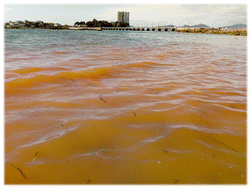Red tides in the Galician rías: historical overview, ecological impact, and future monitoring strategies†
Abstract
The Galician rías (NW Iberia, Spain) are coastal embayments at the northern boundary of the Canary Current upwelling system. Their favourable conditions for phytoplankton growth turn them into a suitable area for the development of aquaculture activities and a site of most of the national shellfish production. Phytoplankton blooms, a natural phenomenon inside the rías, under certain conditions eventually lead to seawater discolourations (colloquially known as “red tides”). Because of their transient nature, available records derive mainly from opportunistic samplings or casual observations, and are scattered in the literature. As a rule of thumb, red tides in the NW Iberian Peninsula are of non-toxic nature and are not systematically monitored. However, in recent years striking exceptions such as those of the toxic dinoflagellate Alexandrium minutum, a producer of paralytic shellfish toxins, have been registered. The present study goes through a historical overview of red tides in the Galician rías, describing their colouring, responsible organisms, seasonal and geographical occurrence, and their association with other features (harmful algal blooms, biotoxins and shellfish harvesting closures, bioluminescence, etc.), ending with social challenges and proposals for improving the monitoring of red tides in the future.

- This article is part of the themed collections: Recent Open Access Articles, Environmental Science: Processes & Impacts: Recent Review Articles, Environmental exposure and impacts and Outstanding Papers 2024 – Environmental Science: Processes & Impacts


 Please wait while we load your content...
Please wait while we load your content...